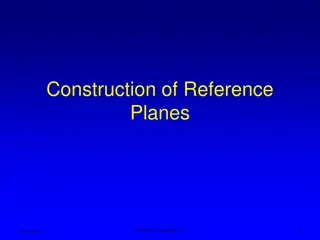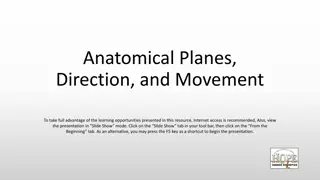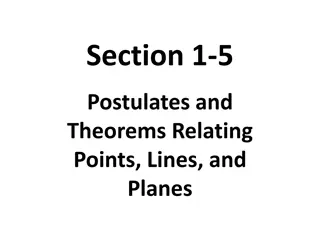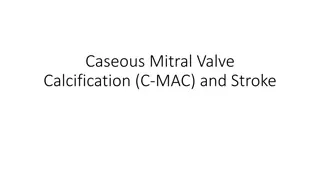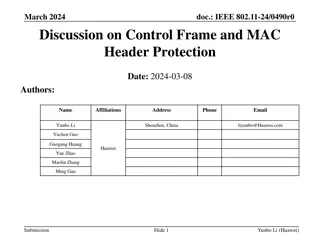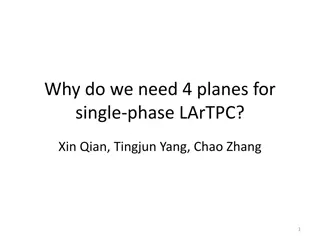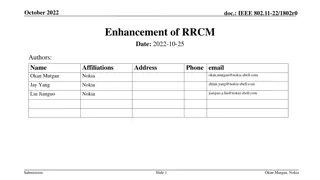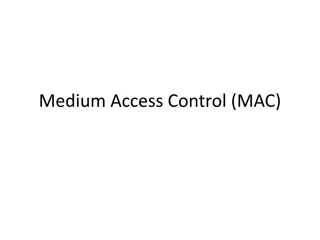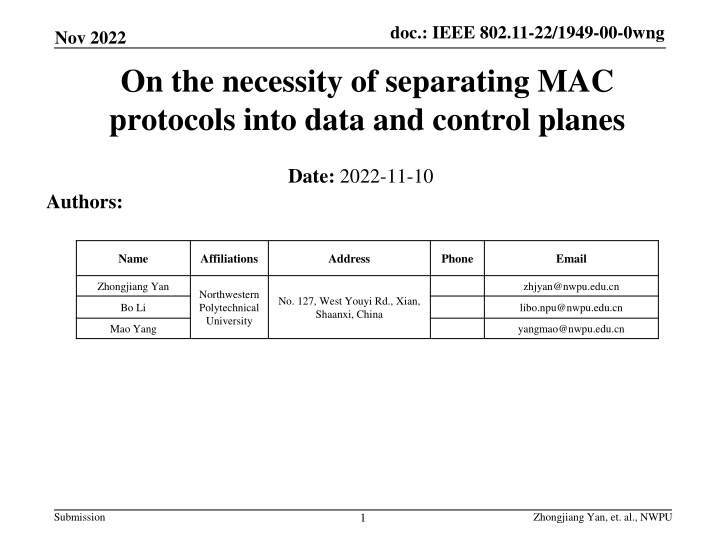
Necessity of Separating MAC Protocols into Data and Control Planes
Explore the importance of dividing MAC protocols into data and control planes in wireless networks through a detailed analysis of features, relationships, and challenges. The discussion highlights the benefits and implications of this separation for efficient communication in IEEE 802.11 networks.
Download Presentation

Please find below an Image/Link to download the presentation.
The content on the website is provided AS IS for your information and personal use only. It may not be sold, licensed, or shared on other websites without obtaining consent from the author. If you encounter any issues during the download, it is possible that the publisher has removed the file from their server.
You are allowed to download the files provided on this website for personal or commercial use, subject to the condition that they are used lawfully. All files are the property of their respective owners.
The content on the website is provided AS IS for your information and personal use only. It may not be sold, licensed, or shared on other websites without obtaining consent from the author.
E N D
Presentation Transcript
doc.: IEEE 802.11-22/XXXr0 doc.: IEEE 802.11-22/1949-00-0wng Nov 2022 On the necessity of separating MAC protocols into data and control planes Date: 2022-11-10 Authors: Name Affiliations Address Phone Email Zhongjiang Yan zhjyan@nwpu.edu.cn Northwestern Polytechnical University No. 127, West Youyi Rd., Xian, Shaanxi, China Bo Li libo.npu@nwpu.edu.cn Mao Yang yangmao@nwpu.edu.cn Submission Zhongjiang Yan, et. al., NWPU 1
doc.: IEEE 802.11-22/XXXr0 doc.: IEEE 802.11-22/1949-00-0wng Nov 2022 Introduction Several contributions were proposed for WNG in previous meetings. Before proceeding, it is time to think about the need to separate MAC into the data and control planes. In Ref. [1], Std 802.11-2020 Fig. 5.1 shows the MAC data plane architecture, i.e., the transports of all or part of an MSDU. Here, MAC control plane involves the processes to establish the wireless link by using MAC control frames. In this contribution, the necessaries to separate the MAC protocols into the data plane (DP) and control plane (CP) are discussed. Details are referred to Ref [4]. 2 Submission Zhongjiang Yan, et. al., NWPU
doc.: IEEE 802.11-22/XXXr0 doc.: IEEE 802.11-22/1949-00-0wng doc.: IEEE 802.11-22/1949-00-0wng Nov 2022 MAC CP-DP features and relationships Features Reliable CP: using low MCS, a few of spatial streams, usually maximum transmission power High rate DP: higher MCS, many spatial streams Coupled relationships Time dependence: Immediately data transmission after successful channel access on the same channel, i.e., handshake of RTS-CTS, or directly data transmission without RTS-CTS Casual dependence: high rate DP depends on reliable CP Submission Zhongjiang Yan, et. al., NWPU 3
doc.: IEEE 802.11-22/XXXr0 doc.: IEEE 802.11-22/1949-00-0wng doc.: IEEE 802.11-22/1949-00-0wng Nov 2022 MAC CP-DP in DCF and EDCA Problem 1: collisions Collisions in CP, e.g., in Fig. (a) hidden terminal problems caused collision between node B sCTS and node D s RTS. Collides between CP and DP, e.g., in Fig. (a) node A s data collides with node C s CTS at node B, and in Fig. (b) node B s ACK collides with node D s Data A B C D A B C D Collision Collision Collision (a) Collisions between CTS and RTS and between Data and CTS (b) Collisions between Data and ACK Submission Zhongjiang Yan, et. al., NWPU 4
doc.: IEEE 802.11-22/XXXr0 doc.: IEEE 802.11-22/1949-00-0wng doc.: IEEE 802.11-22/1949-00-0wng Nov 2022 MAC CP-DP in DCF and EDCA Problem 2: blockings At t1, low rate CP blocks low latency DP At t2, long DP blocks Beacon, i.e., the control or management frames, At t3, long DP blocks low latency DP. Long BE data blocks Beacon Beacon BE_TXOP = 8 ms AP CTS ACK RTS BK-DATA STA1 t2 0.5 ms Low rate access control blocks VO data VO STA2 t1 0.5 ms Long BE data blocks VO data VO STA3 t3 Submission Zhongjiang Yan, et. al., NWPU 5
doc.: IEEE 802.11-22/XXXr0 doc.: IEEE 802.11-22/1949-00-0wng doc.: IEEE 802.11-22/1949-00-0wng Nov 2022 MAC CP-DP in channel binding Problem 3: bottleneck of primary channel Busy primary channel becomes the bottleneck to utilize the secondary ones, since both CP and DP are both evolved in. Even though the bandwidth of the channel bonding increases from 40MHz in 11n to 320MHz in 11be, it results in low usage of channels. ... RTS CTS RTS CTS 20MHz BK-DATA ACK 20MHz 20MHz Channel bonding rules not allowed 20MHz Submission Zhongjiang Yan, et. al., NWPU 6
doc.: IEEE 802.11-22/XXXr0 doc.: IEEE 802.11-22/1949-00-0wng doc.: IEEE 802.11-22/1949-00-0wng Nov 2022 MAC CP-DP in channel binding Problem 4: lower usage of secondary channel More channels, lower usage. Except of bottleneck problem, other reasons include STA capability, channel state and restricted binding rules. ... RTS CTS RTS CTS 20MHz 1. STA is capable of 40MHz channel binding. BK-DATA ACK 20MHz 2. Busy state of secondary channel 20MHz 3. Channel bonding rules not allowed 20MHz Submission Zhongjiang Yan, et. al., NWPU 7
doc.: IEEE 802.11-22/XXXr0 doc.: IEEE 802.11-22/1949-00-0wng doc.: IEEE 802.11-22/1949-00-0wng Nov 2022 MAC CP-DP in data rate increasing Problem 5: relatively reduced efficiency of CP More binding channels, higher data rate of DT. RTS CTS BK-DATA ACK STA AP Bandwidth increased RTS CTS STA AP BK-DATA ACK PHY rate increases with MCS, e.g., from 64QAM to 4096QAM. RTS CTS BK-DATA ACK STA AP Data rate increased RTS CTS BK-DATA ACK STA AP Submission Zhongjiang Yan, et. al., NWPU 8
doc.: IEEE 802.11-22/XXXr0 doc.: IEEE 802.11-22/1949-00-0wng doc.: IEEE 802.11-22/1949-00-0wng Nov 2022 MAC CP-DP in fragmented access interval Problem 6: reduced efficiency of DCF and EDCA rTWT is proposed in 11be draft, which separates the timeline into fragmented access intervals. Fragmented access intervals decrease the efficiency of CP, e.g., DCF and EDCA. Beacon Interval RU 1: STA 4 RU 1: STA 1 RU 1: STA 1 T F B A T F B A T F B A Beacon RU 2: STA 2 Beacon RU 2: STA 2 RU 2: STA 4 ... ... ... ... RU 3: STA 3 RU 3: STA 5 AP & STA RU 3: STA 6 ... ... ... ... Beacon TWT SP1 TWT SP1 TWT SP1 Beacon TWT SP Fragmented access intervals 9 Submission Zhongjiang Yan, et. al., NWPU
doc.: IEEE 802.11-22/XXXr0 doc.: IEEE 802.11-22/1949-00-0wng doc.: IEEE 802.11-22/1949-00-0wng Nov 2022 Conclusions No. Problems Reasons Collisions of intra CPs and between CP and DP Blockings of intra DPs and between CP and DP Bottleneck of primary channel Hidden terminals loss of NAV 1 2 Low rate CP and long time DP exist on the same channel or link. 3 Bottleneck of primary channel Channel binding capabilities/rules Independent secondary channels states Increased bandwidth of DP Increased PHY rate Fragmented access intervals caused by new schemes, e.g., rTWT Low usage of secondary channels 4 Relatively reduced efficiency of CP Reduced efficiency of DCF and EDCA 5 6 Submission Zhongjiang Yan, et. al., NWPU 10
doc.: IEEE 802.11-22/XXXr0 doc.: IEEE 802.11-22/1949-00-0wng doc.: IEEE 802.11-22/1949-00-0wng Nov 2022 Suggestions Useful clues can be found from related works [2-3]. In Ref. [2], we propose an efficient MAC protocol with multiple- step distributed in-band channel reservation. In Ref. [3], we propose a reservation based multi-channel MAC protocol for single radio. Control channel reservation DIFS+ BK DIFS+ BK R T S R T S C T S R E S R E S R E S SIFS SIFS SIFS CH t2 NAV time CTS NAV ... RTS A C K A C K A C K St Datam Data1 Data2 SIFS SIFS SIFS DHS time t3 t1 ... Data channel reservation DHK time Submission Zhongjiang Yan, et. al., NWPU 11
doc.: IEEE 802.11-22/XXXr0 doc.: IEEE 802.11-22/1949-00-0wng Nov 2022 Reference 1. IEEE Std 802.11-2020 (Revision of IEEE Std 802.11-2016) , vol., no., pp.1-4379, 26 Feb. 2021, doi: 0.1109/IEEESTD.2021.9363693. Bo Li, Wei Li, and F. Valois, et al. Performance analysis of an efficient MAC protocol with multiple-step distributed in-band channel reservation[J]. IEEE Transactions on Vehicular Technology, 59, 368-382, 2010. Bo Yang, Bo Li, Zhongjiang Yan, Mao Yang, Der-Jiunn Deng, Performance Analysis of Multi-channel MAC with Single Transceiver for the Next Generation WLAN, J. Network and Computer Applications 146 (2019) http://arxiv.org/abs/2210.08492 2. 3. 4. Submission Zhongjiang Yan, et. al., NWPU 12





